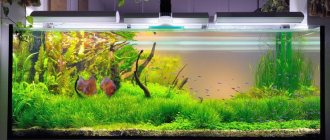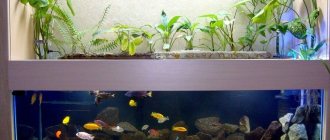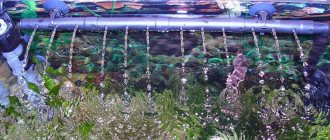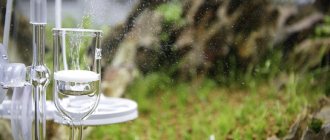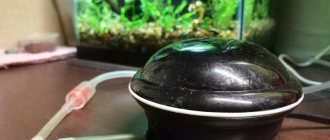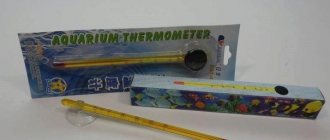Decorative background
Although the background for the fish does not play any role, it emphasizes the beauty of underwater inhabitants, highlights the decorative design and visually enlarges the water space.
Foam and film are used to create a decorative background.
You can find out more about backgrounds for aquariums in another article.
Styrofoam
Foam plastic is used to create a background because it is an inexpensive material from which it is not difficult to make decorations for an aquarium with your own hands. To create a background that resembles a rocky surface, foam is cut to the size of the glass, fired until it bubbles, and coated with a cement base. Once dry, place in the back.
Another option for using polystyrene foam, besides firing it, is to carve certain designs on it. Then you can also cover it with cement or non-toxic and safe paint.
Film
Most often, breeders choose black colors or underwater landscapes as a background in the interior. The color depends on the style of decoration and the presence or absence of artificial decorations. The color black is associated with the darkness of the deep sea. Films with designs of underwater plants, reefs, and corals also increase the volume of the tank and highlight the fish.
Films are sold in pet stores. They also print films to order with individual designs. After purchasing the film, it is important to properly glue it to the glass walls of the aquarium. Do this carefully, smoothing out any bubbles that form. PVC film is considered the most reliable. Its service life is several decades.
Dutch landscape in an aquarium
The deep perspective and naive realism of the landscape migrated from the paintings of old Dutch artists to the world of aquariums.
To create perspective, when decorating a Dutch aquarium, a large number of plants of different sizes are used, contrasting in color and having different sizes of stems and leaves. Tall lush plants with thread-like or very small leaves are placed in the background. Stem shoots with larger foliage are on average. The lowest bushes of algae and those that imitate grass are in the front. This technique creates the feeling of a deep multi-tiered landscape.
Dutch style aquarium
Light and dark green, brown, yellowish and red algae are used for planting. On average, there is 10 cm2 of bottom per plant - this is a dense planting, but it gives the plants the opportunity to develop well and create in the aquarium that abundant green landscape for which the Netherlands is famous. And the passing small but bright fish give it a touch of surrealism.
A large number of bright small fish is a distinctive feature of the Dutch style
Lighting achieves the effect of oblique sunlight, highlighting a piece of green thicket. The Dutch aquarium requires constant care:
- carbon dioxide supply;
- soil fertilization;
- trimming overgrown algae;
- careful selection and regulation of the number of inhabitants.
Such an aquarium will certainly be suitable for a classic interior in a modern interpretation, with elements of modernist chic. It will also be good in an eco-style atmosphere with a touch of the romance of wandering.
Dutch aquarium in the interior
Stones
The simplest means of decoration are stones. They, like decorations for the aquarium, are bought in specialized stores or collected when going out into nature. Choose smooth rocks without sharp edges or cracks that could injure the fish. You also need to pay attention to the composition of the stone. It should not contain limestone. Long-term release of alkali into the water will harm underwater inhabitants. To test a stone for the presence of alkali, you will need vinegar. If vinegar applied to a stone begins to hiss and foam, then the stone is not suitable.
If you do collect stones in nature, then the first thing you should do is disinfect them. Disinfection is carried out using boiling water. To begin with, wash the stones and remove dirt from cracks and crevices with a brush. Then they put it in water and boil for 15 minutes to destroy all bacteria and viruses that are dangerous to fish.
Stones are not only used to line the bottom, but are also used to decorate the aquarium. From them you can make stone structures with your own hands: caves, grottoes or slides.
You can learn more about choosing stones for an aquarium in this article.
Raid
One of the most common problems that arise is that the stones begin to turn green. You can get rid of this. Water and other surfaces often turn green or black. This indicates the appearance of algae. This is not a serious problem, but it is the first sign that the water in the aquarium is starting to bloom, so it is still advisable not to ignore it.
To remove green or black deposits, you just need to carefully monitor the aquarium. Don’t forget to do water changes, don’t add too much food to the fish, check that the filter is working properly and, most importantly, monitor the length of daylight hours. It should not be too large, because excess light is one of the main reasons for the appearance of algae. Special products purchased in the store can also help in getting rid of plaque. Before removing it, the plaque itself is cleaned with a scraper from all accessible places. But without caring for the aquarium, no matter how much you peel off, the algae will not just go away.
Wooden decorative elements
Wooden accessories are purchased at the store. But you can make the decor of an aquarium with your own hands. Not all branches, driftwood and sticks found outside are suitable for decorating an aquarium.
- Pay attention to the type of wood, if possible. Coniferous species are not suitable. In the water, they begin to secrete resinous enzymes that negatively affect fish. Also avoid branches from oak trees. Tannins are released from them.
- Choose only healthy branches. Even a small lesion on the bark will cause infection and rapid rotting of the tree.
- Before making decorations for an aquarium from branches, they are boiled for a long time in salted water and then soaked.
Houses, grottoes, and shelters are built from branches. Driftwood and branches look beautiful without excessive decoration. We wrote more about the use of driftwood in an aquarium separately.
The procedure for filling an aquarium with decor
All the decor discussed above makes no sense if there are no plants, fish and small fauna in the aquarium. It is in order for them to be comfortable that they need to decorate and fill the containers in a certain order.
- Buy everything you need.
- Preparing driftwood and stones is the longest procedure.
- Process the dummies.
- Install the underwater part of the equipment.
- Create a composition from roots, driftwood and dummies.
- Backfill and level the soil.
- Install, if necessary, a pump to simulate a waterfall.
- Moisten the soil and plant the plants. Add some water.
- Secure Java moss with thread/line to the lower tier of driftwood. Add water again. Repeat until vertical gardening is completed.
- Fill the aquarium with water. Connect the equipment.
The arrangement of the aquarium is carried out in several stages
It is important from the very beginning to ensure the supply of carbon dioxide to the aquarium, which promotes the development of algae and improves their survival rate. When the plants in the aquarium take root, you can introduce fish, crustaceans and other inhabitants into it.
Waterfall
The waterfall gives the aquarium a special beauty.
Waterfalls are divided into 2 types:
- Waterfall above the surface. It also performs a useful function - with the help of a flow of water, the water is aerated, that is, filled with oxygen. The sound of flowing water has a calming effect on a person.
- Underwater waterfall. This is just a decorated imitation of a waterfall, but it does not lose its beauty because of this. An underwater waterfall uses sand and a compressor.
Pipe shelters
A simple, inexpensive and quick way is to make shelters for the inhabitants of the aquarium from plumbing polypropylene pipes.
The diameter of the pipes is selected depending on the size of the aquarium, fish, and the wishes of the owner.
- Cut the pipes to the required length.
- Prepare multi-colored small pebbles (soil).
- Carefully lubricate polypropylene blanks with silicone sealant.
- Place the pipe vertically in a container with soil and sprinkle it generously with pebbles. The dishes should be such that you can roll the tubes like a rolling pin with pressure for thorough gluing.
The product is allowed to dry and placed horizontally on the bottom of the aquarium.
Coconut
Shelters or houses made from coconut are often used to decorate an aquarium. To build a coconut shelter, choose a fresh and ripe nut without any damage. Get rid of the inside of the nut. Boil for 10 minutes in salt water, and then soak for another day in warm water.
Decorating an aquarium: photos of interesting ideas
Aquarium decorations are everything that makes a fish tank unique. Special accessories perfectly decorate the water area and attract attention with their aesthetics. The design of the aquarium in the photographs in this article represents many different solutions, among which every fan of the underwater world in miniature will surely find something for themselves. Consider using decorative roots and bark, rocks, photo wallpaper, backdrops and more. A wide selection of aquarium decorations guarantees that everyone will find something in the offer that meets their personal expectations.
Aquarium decorations are an easy way to make your tank more beautiful.
Aquarium decorations create a unique aquatic space. Each element is, above all, a high-quality finish and excellent aesthetics. Decorations will make your aquarium special, a beautiful underwater world and an original, intriguing piece of furniture for every room.
Ceramic products
Ceramic elements are durable in aquariums. Ceramic pots or figurines are lowered to the bottom and firmly fixed. Some Chinese ceramic products emit substances that are harmful to fish health, so be careful when choosing.
Selecting suitable soil
Soil is especially important for plant decoration; it provides support for the roots. When choosing a material, adhere to the following conditions: do not harm the fish. Many representatives of the underwater world love to dig at the bottom or swallow pebbles. The main thing is that they do not get injured or choke. The color range of the soil is important for shellfish and shrimp.
Aquarium background decor
Aquarium decor spongebob
Decor for an aquarium in the living room
Clay aquarium decor
The chemical composition of the bottom design plays an important role. Some materials increase water hardness, which is not suitable for all fish and plants. It is ideal to fill with coarse-grained clean sand, expanded clay or gravel chips (fraction up to 4 mm).
Aquarium decor
Decorative tree for aquarium
Artificial aquarium decor
Decor for aquarium shells
If you decorate the aquarium in a green style, with a large inclusion of algae and other plants, then it is preferable to decorate the bottom with a nutritional composition. It is sold ready-made or mixed independently from sand, garden soil and clay.
Aquarium decor in the form of a steering wheel
Aquarium soil
Decorative grotto for an aquarium
Decor for an aquarium with algae
Grotto
Grottoes are essential for an aquarium; fish use them as shelters and places to rest. Grottoes can be purchased, but they are not difficult to make with your own hands. Almost any material is suitable for production. It can be stones, shells, wood, ceramics, clay. With the help of safe and non-toxic glue and the selected material, the mainsail of various shapes is glued together. The grottoes look good among the algae thickets.
Japanese style underwater rock garden
There are interiors in which the aquarium is stubbornly discordant with the overall design. These include industrial loft and high-tech, as well as sophisticated Japanese style. It was from Japan that the amazing principles of aquadesign came, drawing inspiration from the aesthetics of iwagumi - the art of creating empty space filled with philosophy.
Aquarium in a laconic Japanese style
With spare but expressive means, using soil, sand, carpet algae and a few stones, you can turn a Japanese aquarium into a universe. A school of small fish seems to be flying somewhere in infinity, over a desert planet.
Picturesque aquarium in Japanese style
Stones play a major role in the Japanese aquarium. There can be three or four of them - one large (main), one or two additional and one very small, “sacrificial”. Models of stones designed specifically for Japanese compositions will help you decorate such an aquarium yourself.
Setting up a Japanese aquarium
Continuing Japanese minimalist traditions, aquascape lovers began to create rocky compositions free from canons with islands of low-growing carpet algae. The discreet, elegant design is also suitable for an aquarium with small fish.
General decorating rules
Sometimes aquarists get so carried away with decoration, forgetting that fish will live among this decor. The decor should first of all be comfortable for pets, and only then beautiful.
Therefore, when decorating, observe some design nuances and fundamental principles:
- Don't use too much decoration. Pisces need room to swim.
- It is advisable to place the decor in the back of the aquarium, and not in the central part.
- Using decoration, it is good to hide devices for fish life, for example, a filter, compressor, aerator.
How to install a background yourself
The internal background, as a rule, imitates some natural object: stones, driftwood, bamboo thickets, cork tree bark.
This background is good for aquariums with large fish, in which large decorations for the aquarium would not be entirely appropriate, besides, large fish like to swim rapidly, dropping decorations, and some species dig them up.
There are relief backgrounds that protrude over most of the aquarium, and there are relatively flat ones.
The back wall of the tank can be decorated with purchased materials or made independently from improvised materials. Let's consider the second option.
Materials for self-production:
- a sheet of thick cardboard with dimensions corresponding to the dimensions of the back wall;
- leaves of dry grass, seeds, peelings of tree bark;
- watercolor paints;
- glue.
Manufacturing stages:
- A sheet of cardboard is completely covered with black paint.
- After the paint has dried, apply glue (you can use a glue stick) to the entire surface of the cardboard.
- The harvested grass is carefully distributed over the entire sheet and rolled with a rolling pin to better fix the particles.
- Unadhered excess is removed and, if necessary, gaps are sealed.
The finished background is attached to the back wall of the aquarium from the outside. This is just one option out of many possible ones.
Look at 1 more manufacturing option:
Decorating an aquarium with plants
Aquarium plants are more than just decoration for your water tank. They are an important element of the ecosystem of every aquarium. Plants absorb nutrients from water and soil, reduce carbon dioxide in liquids, and release oxygen.
Java moss (Taxiphyllum barbieri)
Java moss can float freely in the water and attach to rocks or roots, so it can be placed anywhere in the aquarium. In addition, it requires very little light and tolerates a wide range of water hardness levels and temperatures. This makes it suitable for almost any aquarium.
Anubias (Anubias barteri var. Nana)
Where possible, Anubias should be attached to other plants, decorations or roots, but they can be planted directly into gravel. Most species have low water hardness and nutrient requirements and perform well in low light conditions.
Cryptocoryne wendtii
Cryptocoryne is native to Sri Lanka and grows up to 30 cm in height. It is a fast growing plant that can thrive in low light and a wide range of water hardnesses. Suitable for almost any aquarium, especially newly created ones, where it quickly eliminates the feeling of emptiness. Available in several different shapes and colors.
Nurzanets (Vallisneria)
The tall, slender ribbon shape makes it an ideal plant for the rear areas of large aquariums. However, care should be taken when choosing specific species because the leaves of some plants can reach 150 cm in length. Works great in low light conditions and grows well in sandy soil. It can often be found in most pet stores because it thrives even in hard water.
Algae (Aegagropila linnaei)
Generally, algae are not welcome in an aquarium, except for those decorative and slow-growing, sphere-shaped species. These undemanding, thin balls of moss provide a food source for shrimp and are also ideal for nano aquariums. They can be easily cleaned by rinsing under running water. Just make sure the water isn't warm because the spherical branches don't like it.
Decorating an aquarium with driftwood
Asian rhododendrons' roots, which are naturally water-resistant, have a unique shape. They provide aquarium decoration, shelter for fish, and food for aquatic life. There are many advantages:
- create an excellent refuge for fish;
- The unique shape is a chic decoration;
- suitable for any biotope;
- ideal for planting mosses;
- combine harmoniously with plants such as anubias and microsorium.
Popular examples of aquarium design
A variety of aquarium decorations also have a positive effect on the organisms living in this home aquatic tank. Various structures, rocks with small caves and even decorative ships or castles diversify the space in which fish live every day, making it look like a natural, diverse marine environment. Most fish species love to hide in the corners of the aquarium and find new hidden places to live, so the animals will also benefit from new decorations.

